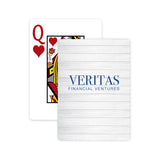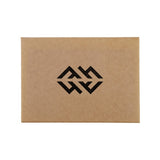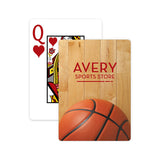Custom Playing Cards
Low-priced Customized Playing Cards Imprinted with your Logo for your next event. You're here for quality. It's not always easy, So we take it seriously.
Custom Personalized Playing Cards - 53 Items Found

Standard Playing Cards (Q285011)

Playing Cards In Case (Q185011)

Valu Deck Playing Card (Q569122)

Standard Playing Cards (Q391022)

Solid Backs Playing Cards (Q397911)

Theme Backs Playing Cards - Multi-Color Frame2 (Q308911)

Theme Backs Playing Cards - Shiplap (Q908911)

Theme Backs Playing Cards - Pattern 1 (Q218911)

Custom Backs Playing Cards (Q428911)

Custom Backs and Faces Playing Cards (Q528911)

Euchre Playing Cards (Q995022)

Rook Game Playing Cards (Q106022)

Spanish Poker Playing Cards (Q206022)

Pinochle Playing Cards (Q606022)

Jack 2-Pack Kraft Paper Playing Card Set (Q983022)

Theme Backs Playing Cards - Baseball (Q497911)

Theme Backs Playing Cards - Basketball (Q597911)

Theme Backs Playing Cards - Soccer Ball (Q697911)

Theme Backs Playing Cards - Ice Hockey (Q797911)

Theme Backs Playing Cards - Football (Q897911)
- ←
- 1
- 2
- 3
- Show All Products
- Next →
Quality Imprint customer experience rating
See what our customers think of QualityImprint
- There was an error in the printing of our item, however they did work to correct the error and get the item replaced for us.
- Perfect! and the cost was within our budget. They were received on time and everyone thinks our drumstick pens are so much fun!
- Communication was timely, detailed and very helpful, and they made sure we were content with the mock-up before moving forward.
Need help ordering Playing Cards? Call 1-888-377-9339
The Comprehensive Guide to Playing Cards: Customization, Industry Insights, and More
Playing cards have captivated audiences for centuries, evolving from simple hand-painted designs to mass-produced decks used worldwide. Today, playing cards are not just for games; they serve as tools for magic, advertising, and personalization. This guide delves into various aspects of playing cards, including custom playing cards, promotional playing cards, and personalized playing cards, while addressing key topics like production, industry size, and material choices.
How Are Professional Playing Cards Made?
Professional playing cards undergo a meticulous production process to ensure high quality and durability. The journey begins with the design phase, where graphic designers create intricate artwork for the card faces and backs. Next, high-quality card stock, often paper coated with plastic or 100% plastic, is selected for printing. The cards are then printed using high-resolution offset printing, coated for durability, cut to precise dimensions, and subjected to rigorous quality control before packaging. Custom playing cards follow a similar process, with additional steps for personalized designs.
How Big Is the Playing Card Industry?
The playing card industry is a multi-billion-dollar market, valued at approximately $3 billion, with a steady growth rate of 2-3% annually. Key segments include traditional playing cards, collectible card games (CCGs), and promotional playing cards. The industry's growth is driven by the enduring popularity of card games, the rise of CCGs, and the increasing use of custom and promotional cards for marketing purposes. North America, Europe, and Asia-Pacific are the largest markets, each with unique cultural and economic contributions to the industry.
What Are the Pictures on Playing Cards Called?
The pictures on playing cards, known as face cards or court cards, include the King, Queen, and Jack (or Knave). These cards are part of the standard 52-card deck, which also features number cards with pips. The face cards have a rich history, often depicting historical or mythical figures, and are integral to the game's strategy and aesthetic appeal. Personalized playing cards can incorporate custom images, adding a unique touch to the traditional face card designs.
What Is the Best Material for Playing Cards?
Playing cards are typically made from paper card stock, plastic-coated paper, or 100% plastic. Each material has its advantages:
- Paper Card Stock: Affordable and easy to print on, but less durable.
- Plastic-Coated Paper: Offers a good balance of durability and cost.
- 100% Plastic Cards: Extremely durable and waterproof, ideal for professional and casino use. For custom playing cards, the choice of material should align with the intended use, budget, and desired longevity.
What Is the Most Common Type of Playing Cards?
The standard 52-card deck is the most common type of playing cards, used in a wide range of games including Poker, Bridge, and Solitaire. This deck consists of four suits (hearts, diamonds, clubs, spades), each with 13 cards (Ace, 2-10, Jack, Queen, King). The versatility and widespread recognition of this deck make it a popular choice for both casual and professional play. Custom and promotional playing cards often use this standard format, adding personalized designs to the card faces and backs.
What Paper Is Used for Playing Cards?
Playing cards are commonly made from high-quality paper card stock that is either plastic-coated or laminated for durability. This specialized paper is designed to withstand frequent handling, shuffling, and dealing. The paper used in promotional playing cards should be of high quality to ensure that the custom designs are vibrant and long-lasting.
What Size Is a Standard Playing Card?
The standard size for playing cards is typically:
- Poker Size: 2.5 inches x 3.5 inches
- Bridge Size: 2.25 inches x 3.5 inches These sizes are widely used in both casual and professional settings, with poker size being slightly larger and more versatile. Custom playing cards can be made in either size, depending on the preference and intended use.
What Size Playing Cards Do Casinos Use?
Casinos primarily use poker-sized cards (2.5 inches x 3.5 inches) for most games. This size offers a larger surface area for clearer graphics and easier handling. In games like Blackjack, bridge-sized cards (2.25 inches x 3.5 inches) might be used for ease of handling multiple cards. The choice of size in custom playing cards for casino use should align with these standards to ensure familiarity and ease of use.
What to Look for When Buying Playing Cards?
When purchasing playing cards, consider factors such as:
- Card Stock Quality: Durable materials like plastic-coated paper or 100% plastic.
- Finish: Smooth or textured finishes affect handling and shuffling.
- Design and Aesthetics: Choose designs that are visually appealing and functional.
- Size: Poker or bridge size depending on the intended use.
- Purpose: Casual play, professional use, or promotional purposes. Custom playing cards should also reflect the desired branding or personalization to enhance their appeal and utility.
Which Playing Card Has the Highest Value?
In most traditional card games, the Ace is considered the highest value card, especially in games like Poker and Blackjack. However, the highest value card can vary depending on the specific game rules. Custom playing cards can feature unique designs for the Ace and other high-value cards, making them stand out in a deck.
Conclusion
The playing card industry is vast and varied, encompassing everything from traditional games to modern promotional tools. Whether you're interested in the production process, the materials used, or the market size, understanding these aspects can enhance your appreciation and use of playing cards. Custom playing cards offer a unique way to engage with this timeless medium, providing opportunities for personalization and branding.
For more information on customizing your own playing cards, call 1-888-377-9339 or email care@qualityimprint.com. Enhance your marketing strategy or special event with QualityImprint today!








